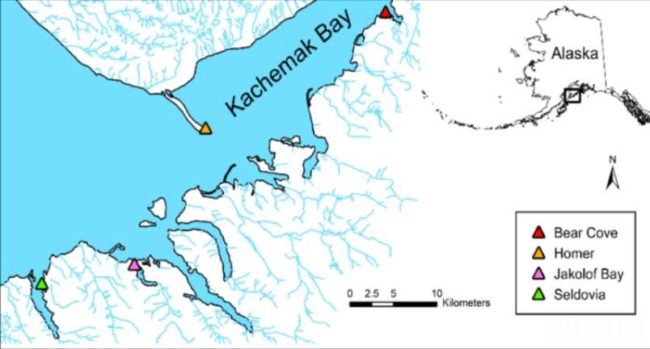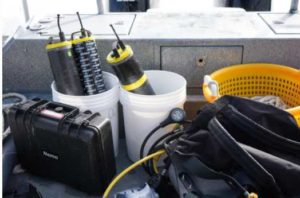
Alaska’s coastal waters are some of the most commercially valuable and productive ecosystems on the planet. Ocean acidification—a decrease in ocean pH caused by increasing concentrations of carbon dioxide—is expected to impact these ecosystems, but very little is known about how it could alter nearshore environments.

Nearshore ecosystems provide habitat and serve as a nursery for juvenile fish and shellfish. Even small changes in pH could affect the development of organisms such as plankton, shrimp and oysters, with implications for other animals higher on the food chain, including salmon. Understanding how pH fluctuates in these shallow coastal waters will help scientists and resource managers determine what ocean acidification could mean for commercially important species.
UAF College of Fisheries and Ocean Sciences professor Amanda Kelley and graduate student James Currie are collecting data from Kachemak Bay to gain more insight into how pH conditions are changing in Alaska’s nearshore waters. Using a combination of manual field sampling and data from autonomous underwater pH sensors called SeaFETs (Sea Field Effect Transistors), they are compiling physical and chemical information to inform current and future ocean acidification studies.

Kelley and Currie’s research is characterizing variability in pH that occurs naturally from year to year in nearshore ecosystems. This information provides a baseline for future pH changes to understand how ocean acidification may be affecting the physiology of animals that live in these habitats. “The key to determining the role that ocean acidification might play in nearshore biological communities in the future lies in increased understanding of present-day carbonate system dynamics” said Kelley. “Increasing our knowledge of nearshore pH dynamics will help detangle natural versus human-caused pH variability.” This work may also be useful in determining areas for future shellfish and seaweed farming.
Kachemak Bay was selected as a site for data collection because of its diverse marine habitats, biological productivity, pH variability, and ease of accessibility for monitoring. The SeaFET devices, installed in four locations around Kachemak Bay, are crucial to the success of the project. Once installed, they require maintenance a few times a year and are capable of continuous collection of data. “They record the pH of the seawater, along with the oxygen concentration, salinity, temperature and photosynthetically active radiation every hour,” said Currie. In nearshore waters, pH is influenced by many factors including glacial outflow, tidal currents, snow melt, biological activity and plankton blooms, and can change minute to minute. “With the SeaFETs we are able to capture at a high level of frequency the full range of variability of pH and carbonate chemistry conditions that can exist here.”
Sourcce: Alaska Sea Grant
